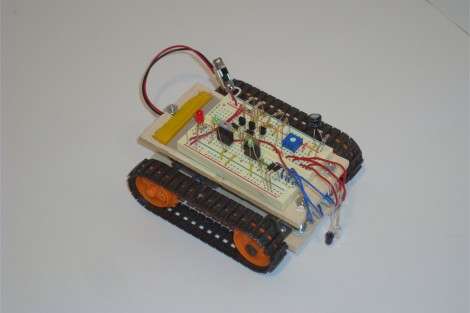
This line following tank uses analog circuitry to sense where a dark line is and adjust its course. Despite the opening paragraph on the schematic page (which looks to be leftover from a past project writeup) this circuit relies on a set of transistors for motor control. [Chris] does a great job of explaining the setup in detail; it boils down to a phototransistor detecting reflected light and flipping which motor is running based on what is detected. A couple of potentiometers are included to tune up the accuracy of the circuit. There’s a short clip of the treaded-terror making a loop around the track after the break.
This is another great way to try your hand at analog circuitry. Once you’ve built the body (tank or otherwise) and line tracking circuit it can be repurposed by swapping out the brains for your next project.
[youtube=http://www.youtube.com/watch?v=fA_tsduqYDU&feature=player_embedded]















Is it just me or does that *really* sound like manic laughter in the video?
and I remember making these when we were about 13 at school, had to race them round a track which was pretty fun :P
Just a quick glance at this article makes me think of the BEAM robotics from years ago. I’m glad to see that people still make things (including robotics), without using microcontrollers (as simple as they can make things). Nice.
reminds me of the robotic kits i would make when i was a kid that were line following using all passive and analog devices
personally non-microcontroller robotics is old news to me they have been around longer than microcontroller robotics
but for thoes who have not seen these robotics try it! … if done right they almost never mess up XD
I remember Edmund Scientific having a kit just like this back before they got…silly.
Very nice writeup of the project! i love the completeness with parts list and building guide! nice project!
We used to build these in a LEGO Robotics course I taught for kids about a decade ago. Lots of fun.
It’s only a matter of time before someone puts together a racing league for these things. Like Solo Racing and Autocross for robots.. sounds like fun to me!
yep, it sounds like a laughing hyena… but works like a charm :-)
bah, line straddling would be simpler.. and better chance of taking out neighbors if eyes are set wide enough.
wonderful!
the best write up, i have seen in a long time. great pictuers, good explanations. not just the usual look-whative-done-video, this is something one can try with kids on a rainy sunday.
great!!
all my annoyance about instructables -this makes up for everything.
I always wonder why Myth Busters don’t use a similar setup instead of their clunky RC controllers. Half their car stunts are fubar’d because they can’t hit the ramp/other car/etc straight on.
Ah Edmund…I live within driving distance of Barrington.
Good times, good times.
Anyone else think it looks like a naked bigtrak:D
@vonskippy: Because so much potential speed is lost in the terrible jerking motions of line-followers.
I have to admit I wonder about mythbusters too. Grant is supposed to be an EE, so I’m surprised that they never manage to build a good steering and control system.
This was probably the most fun project I did in first year compsci. We started off with a basic breadboard, sensors, and wires, and had to make the car successfully follow a line. then we swapped out our circuitry for a microcontroller, and had to reproduce the same effect with assembler.
If you got the code working, there were bonus points for the most efficient and smooth line tracking – they had a bunch of pre-prepared lines designed to throw your car off the scent.
Fifty to a hundred years ago. It was done.
Calculus. Friends don’t let friends derive drunk. Your results will be all over the place.
… for anyone who hasn’t read Braitenberg’s book, “Vehicles” I’d highly recommend it… You can get full text from a link on the Wiki page.
What can possibly be more awesome than driving a car or bigger verhicle with a RC remote….
the mythbusters team has the best job ever!
I remember reading about this kind of “robot” in electronics book from the 80’s :)
Hey, I made one of those: http://projects.iamtheb.org/line_follower.shtml
Also no uC, but with an ultrasonic pre-crash sensor too.
Nice base! Same base as my bot. Tank treads are awesome.
what the connect sensor to easy pic v7